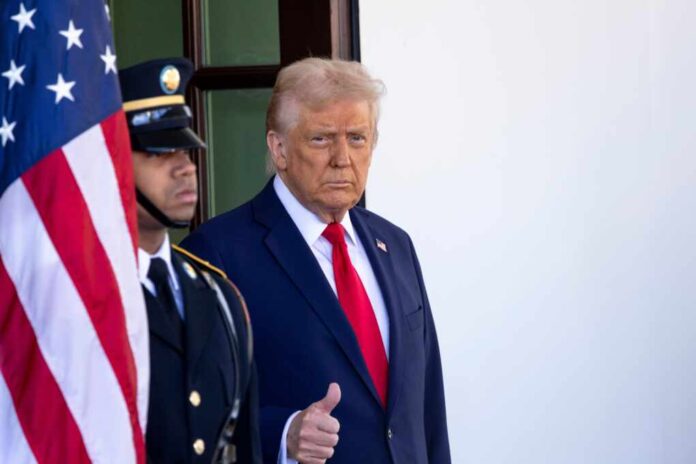
Customs duty collections have smashed through the $100 billion barrier for the first time in U.S. history, all thanks to a tariff policy that’s giving Washington a taste of fiscal discipline—while the usual suspects are howling from the cheap seats about the supposed horrors of American protectionism.
At a Glance
- U.S. customs duty collections soared past $100 billion in a single fiscal year under Trump’s renewed tariff regime.
- New tariffs target China, Canada, Brazil, and key sectors like semiconductors and pharmaceuticals, with even bigger rate hikes coming August 1.
- The de minimis exemption for low-value imports is being eliminated, slamming the brakes on duty-free e-commerce from China.
- Federal revenue windfall has delivered a rare budget surplus, but importers and consumers are bracing for higher costs.
Tariff Tsunami: Customs Revenue Hits Historic High
For all the noise about “endless spending” and the government’s addiction to printing money, here’s a plot twist: customs duties have surged to $100 billion for the first time ever, courtesy of Trump-era tariffs that are back with a vengeance. According to the U.S. Treasury, June alone brought in a record $37 billion in customs duties, a jaw-dropping 109.5% increase over the same period last year. Treasury Secretary Scott Bessent is already projecting tariff income could climb to $300 billion by year’s end, dwarfing the “peanuts” Congress usually squabbles over.
🚨Trump tariffs result in U.S. customs duties topping $100B for ‘first time in a fiscal year’
U.S. customs duty collections surged again back in June as President Donald Trump’s tariffs gained momentum, surpassing $100 billion for the first time in a fiscal year. This helps… pic.twitter.com/d75bhHqYWr
— Tony Seruga (@TonySeruga) July 12, 2025
This revenue spike is no accident. Since returning to office, President Trump has wielded tariffs like a sledgehammer—raising rates, expanding targets, and shutting down loopholes that foreign e-commerce giants have been abusing for years. The administration’s latest moves include 50% tariffs on copper and Brazilian goods, 35% on Canadian imports, and new sector-based levies on semiconductors and pharmaceuticals. Mark your calendars: August 1 is the deadline for even higher “reciprocal” tariffs, with only a handful of trading partners scrambling for last-minute exemptions.
Watch a report: Trump Tariffs Push US Customs Revenue Past $100 Bn
De Minimis Loophole: Game Over for Duty-Free E-Commerce
The so-called “de minimis” exemption—allowing low-value imports to waltz into the U.S. duty-free—has finally met its end. This loophole, which let Chinese e-commerce juggernauts like Shein and AliExpress ship billions in cheap goods straight to American doorsteps without paying a dime in duties, is being shut down. Trump’s executive orders first targeted China, Mexico, and Canada, closing the loophole for those countries back in February. By July 4, the One Big Beautiful Bill Act was signed, spelling the total demise of de minimis for all countries by 2027.
Importers are howling, naturally—they’ve milked this system for years while American manufacturers and workers got steamrolled. Now, those who built their business model on circumventing U.S. tariffs are suddenly “concerned” about higher costs and supply chain “disruptions.” Forgive me if I do not shed a tear for the multinational middlemen who’ve outsourced our supply chains and jobs to chase a quick buck.
Winners, Losers, and the Battle Over American Protectionism
Washington’s sudden windfall from tariffs has even produced a $27 billion budget surplus for June—a rare sight in a town addicted to red ink. The administration is touting this as a fiscal masterstroke, a way to “bring in the big money” and finally fund government priorities without jacking up income taxes on working families. Yet the usual suspects—think tanks, lefty economists, and globalist lobbyists—are warning that tariffs act as a tax on U.S. businesses and consumers, not foreign exporters. They predict retaliation, higher prices, and trade wars as if this is some kind of economic Armageddon.
Let’s be clear: tariffs are not a silver bullet. There will be pain for importers, and yes, some price increases for consumers—especially for goods that have long escaped paying their fair share thanks to de minimis. But after decades of “free trade” policies that gutted American industry and lined the pockets of foreign competitors, is it really so outrageous to demand a level playing field? The CBO estimates tariff income could total $2.8 trillion over 10 years. Even if that’s optimistic, it’s a far cry from the bottomless pit of deficit spending we’ve come to expect from Washington.

























